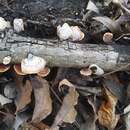pms
nòm ant ël fil


Stereum ostrea, also called false turkey-tail and golden curtain crust, is a basidiomycete fungus in the genus Stereum. It is a plant pathogen and a wood decay fungus. The name ostrea, from the word 'oyster', describes its shape.[2] With concentric circles of many colors, it highly resembles Trametes versicolor, turkey-tail, and is thus called the 'false turkey-tail'. The stemless fruiting body is shell-like and grows 1–7 cm (0.39–2.76 in) high. It is tough and inedible. It grows on tree bark. This fungus is native to North America, where it is widespread and grows all year round.
It gets its name 'false turkey-tail' because it mimics Trametes versicolor. They can be distinguished as T. versicolor has numerous pores on the underside of its fruiting body, unlike S. ostrea.[4] Also, S. ostrea is more red in color. Factors such as its relatively large size and shell-like (not flat) body distinguish it from other members of the genus Stereum.[1]
The fruiting body is 1–7 cm (0.39–2.76 in) wide, shaped like a shell and thin. Its surface can be hairy or smooth at the very first, growing smoother with age. The concentric zones can have a variety of colors - ranging from yellowish red to a dark brown. If algae grow on it, the color can change to green. The flesh is very thin and too tough to eat, with no distinct odor.[1] The fungus lacks a stem. The underside is smooth and lacks pores, white to gray or a reddish-brown shade in color. The spore is white, and measures 5.5–7.5 μm (0.0055–0.0075 mm) x 2–3 μm (0.0020–0.0030 mm).[1][5]
It is inedible.[6]
Stereum ostrea produces lignolytic enzymes, which decompose lignin. The enzyme production was compared for ten days with Phanerochaete chrysosporium, in a liquid medium. S. ostrea produced a higher number of laccase, lignin peroxidase and manganese peroxidase enzymes. the discoloration of the dye Remazol confirmed the presence of enzymes.[7][8][9]
Methoxylaricinolic acid and laricinolic acid have been isolated from this mushroom.[10] Sterostreins A–E (1, 2, 3a/3b, 4, and 5) have been found in S. ostrea, of which sterostrein A showed antimalarial activity and was cytotoxic.[11]
Stereum ostrea is saprophytic in nature. It is a plant pathogen, growing on hardwood tree barks, especially oak, and decaying parts. It leaves white deposits in these places. It grows individually, but in a dense manner. Phlebia incarnata, another fungus, is most commonly found growing alongside or even intermingled with this species. This fungus can be parasitized by jelly fungi. It grows all year round and is widespread in North America.[1][12]
Stereum ostrea, also called false turkey-tail and golden curtain crust, is a basidiomycete fungus in the genus Stereum. It is a plant pathogen and a wood decay fungus. The name ostrea, from the word 'oyster', describes its shape. With concentric circles of many colors, it highly resembles Trametes versicolor, turkey-tail, and is thus called the 'false turkey-tail'. The stemless fruiting body is shell-like and grows 1–7 cm (0.39–2.76 in) high. It is tough and inedible. It grows on tree bark. This fungus is native to North America, where it is widespread and grows all year round.
Stereum ostrea est une espèce de champignons corticioïdes basidiomycètes de la famille des Stereaceae.
Stereum ostrea est une espèce de champignons corticioïdes basidiomycètes de la famille des Stereaceae.
Den mykologiska karaktären hos Stereum ostrea:
![]()
hymenium:
rör
![]()
skivtyp:
nedlöpande
![]()
ätlighet:
oätlig
![]()
fot:
inte tillämpbart
![]()
sporavtryck:
vit
![]()
ekologi:
saprofyt
Stereum ostrea är en svampart[17] som först beskrevs av Carl Ludwig Blume och Theodor Friedrich Ludwig Nees von Esenbeck, och fick sitt nu gällande namn av Elias Fries 1838. Stereum ostrea ingår i släktet Stereum och familjen Stereaceae.[18][19] Inga underarter finns listade i Catalogue of Life.[18]
Stereum ostrea är en svampart som först beskrevs av Carl Ludwig Blume och Theodor Friedrich Ludwig Nees von Esenbeck, och fick sitt nu gällande namn av Elias Fries 1838. Stereum ostrea ingår i släktet Stereum och familjen Stereaceae. Inga underarter finns listade i Catalogue of Life.


Stereum ostrea là một loài nấm gây hại cho thực vật và nấm phân hủy gỗ bản địa của Bắc Mỹ.
Stereum ostrea là một loài nấm gây hại cho thực vật và nấm phân hủy gỗ bản địa của Bắc Mỹ.